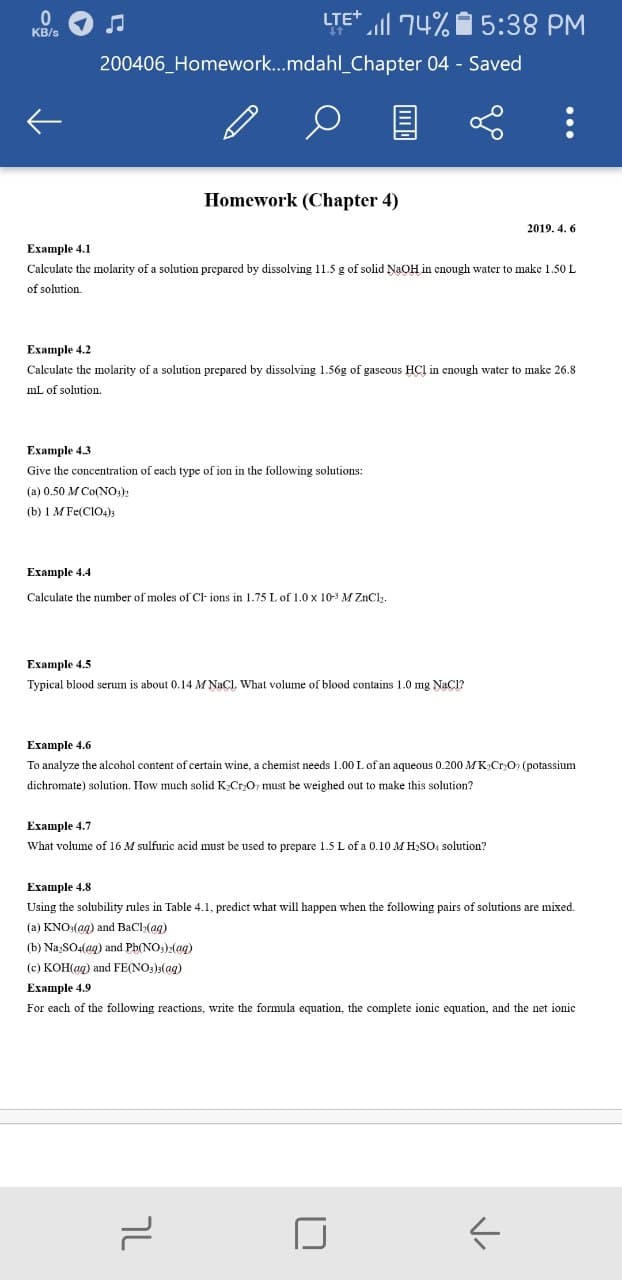LTE+ 74% 5:38 PM KB/s 200406_Homework..mdahl_Chapter 04 - Saved Homework (Chapter 4) 2019. 4. 6 Example 4.1 Calculate the molarity of a solution preparcd by dissolving 11.5 g of solid NaOH in enough water to make 1.50 L of solution Example 4.2 Calculate the molarity of a solution prepared by dissolving 1.56g of gascous HCl in enough water make 26.8 mL of solution. Ехample 4.3 Give the concentration of each type of ion in the following solutions: (a) 0.50 M Co(NO:) (b) 1 M Fe(ClO4)3 Example 4.4 Calculate the number of moles of Cl ions in 1.75 L of 1.0 x 10-3 M ZnCl,. Ехample 4.5 Typical blood serum is about 0.14 M NaCl, What volume of blood contains 1.0 mg NaCl? Example 4.6 To analyze the alcohol content of certain wine, a chemist needs 1.00 L of an aqueous 0.200 MK CrO (potassium dichromate) solution. How much solid K CrO, must be weighed out to make this solution? Ехample 4.7 What volume of 16 M sulfuric acid must be used prepare 1.5 L of a 0.10 M H,SO, solution? Ехample 4.8 Using the solubility rules in Table 4.1, predict what will happen when the following pairs of solutions are mixed. (a) KNO:(ag) and BaCla(ag) (b) Na,SO4(ag) and Ph(NO:)2(ag) (c) KOH(ag) and FE(NO,)3(ag) Example 4.9 For each of the following reactions, write the formula equation, the complete ionic equation, and the net ionic טך
LTE+ 74% 5:38 PM KB/s 200406_Homework..mdahl_Chapter 04 - Saved Homework (Chapter 4) 2019. 4. 6 Example 4.1 Calculate the molarity of a solution preparcd by dissolving 11.5 g of solid NaOH in enough water to make 1.50 L of solution Example 4.2 Calculate the molarity of a solution prepared by dissolving 1.56g of gascous HCl in enough water make 26.8 mL of solution. Ехample 4.3 Give the concentration of each type of ion in the following solutions: (a) 0.50 M Co(NO:) (b) 1 M Fe(ClO4)3 Example 4.4 Calculate the number of moles of Cl ions in 1.75 L of 1.0 x 10-3 M ZnCl,. Ехample 4.5 Typical blood serum is about 0.14 M NaCl, What volume of blood contains 1.0 mg NaCl? Example 4.6 To analyze the alcohol content of certain wine, a chemist needs 1.00 L of an aqueous 0.200 MK CrO (potassium dichromate) solution. How much solid K CrO, must be weighed out to make this solution? Ехample 4.7 What volume of 16 M sulfuric acid must be used prepare 1.5 L of a 0.10 M H,SO, solution? Ехample 4.8 Using the solubility rules in Table 4.1, predict what will happen when the following pairs of solutions are mixed. (a) KNO:(ag) and BaCla(ag) (b) Na,SO4(ag) and Ph(NO:)2(ag) (c) KOH(ag) and FE(NO,)3(ag) Example 4.9 For each of the following reactions, write the formula equation, the complete ionic equation, and the net ionic טך
Chemistry
10th Edition
ISBN:9781305957404
Author:Steven S. Zumdahl, Susan A. Zumdahl, Donald J. DeCoste
Publisher:Steven S. Zumdahl, Susan A. Zumdahl, Donald J. DeCoste
Chapter1: Chemical Foundations
Section: Chapter Questions
Problem 1RQ: Define and explain the differences between the following terms. a. law and theory b. theory and...
Related questions
Question
100%

Transcribed Image Text:LTE+
74% 5:38 PM
KB/s
200406_Homework..mdahl_Chapter 04 - Saved
Homework (Chapter 4)
2019. 4. 6
Example 4.1
Calculate the molarity of a solution preparcd by dissolving 11.5 g of solid NaOH in enough water to make 1.50 L
of solution
Example 4.2
Calculate the molarity of a solution prepared by dissolving 1.56g of gascous HCl in enough water
make 26.8
mL of solution.
Ехample 4.3
Give the concentration of each type of ion in the following solutions:
(a) 0.50 M Co(NO:)
(b) 1 M Fe(ClO4)3
Example 4.4
Calculate the number of moles of Cl ions in 1.75 L of 1.0 x 10-3 M ZnCl,.
Ехample 4.5
Typical blood serum is about 0.14 M NaCl, What volume of blood contains 1.0 mg NaCl?
Example 4.6
To analyze the alcohol content of certain wine, a chemist needs 1.00 L of an aqueous 0.200 MK CrO (potassium
dichromate) solution. How much solid K CrO, must be weighed out to make this solution?
Ехample 4.7
What volume of 16 M sulfuric acid must be used
prepare 1.5 L of a 0.10 M H,SO, solution?
Ехample 4.8
Using the solubility rules in Table 4.1, predict what will happen when the following pairs of solutions are mixed.
(a) KNO:(ag) and BaCla(ag)
(b) Na,SO4(ag) and Ph(NO:)2(ag)
(c) KOH(ag) and FE(NO,)3(ag)
Example 4.9
For each of the following reactions, write the formula equation, the complete ionic equation, and the net ionic
טך
Expert Solution
This question has been solved!
Explore an expertly crafted, step-by-step solution for a thorough understanding of key concepts.
This is a popular solution!
Trending now
This is a popular solution!
Step by step
Solved in 5 steps with 2 images

Recommended textbooks for you

Chemistry
Chemistry
ISBN:
9781305957404
Author:
Steven S. Zumdahl, Susan A. Zumdahl, Donald J. DeCoste
Publisher:
Cengage Learning

Chemistry
Chemistry
ISBN:
9781259911156
Author:
Raymond Chang Dr., Jason Overby Professor
Publisher:
McGraw-Hill Education

Principles of Instrumental Analysis
Chemistry
ISBN:
9781305577213
Author:
Douglas A. Skoog, F. James Holler, Stanley R. Crouch
Publisher:
Cengage Learning

Chemistry
Chemistry
ISBN:
9781305957404
Author:
Steven S. Zumdahl, Susan A. Zumdahl, Donald J. DeCoste
Publisher:
Cengage Learning

Chemistry
Chemistry
ISBN:
9781259911156
Author:
Raymond Chang Dr., Jason Overby Professor
Publisher:
McGraw-Hill Education

Principles of Instrumental Analysis
Chemistry
ISBN:
9781305577213
Author:
Douglas A. Skoog, F. James Holler, Stanley R. Crouch
Publisher:
Cengage Learning

Organic Chemistry
Chemistry
ISBN:
9780078021558
Author:
Janice Gorzynski Smith Dr.
Publisher:
McGraw-Hill Education

Chemistry: Principles and Reactions
Chemistry
ISBN:
9781305079373
Author:
William L. Masterton, Cecile N. Hurley
Publisher:
Cengage Learning

Elementary Principles of Chemical Processes, Bind…
Chemistry
ISBN:
9781118431221
Author:
Richard M. Felder, Ronald W. Rousseau, Lisa G. Bullard
Publisher:
WILEY